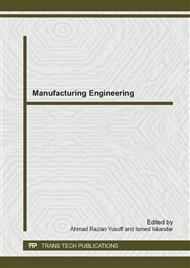p.3
p.9
p.15
p.21
p.27
p.33
p.39
p.45
Tool Life and Flank Wear of Physical Vapour Deposited TiAlN Multilayer Coated Carbide End Mill Inserts when Machining AISI D2 Hardened Steel under Dry Cutting Condition
Abstract:
This study investigates the tool wear of PVD TiAlN multilayer coated end mill inserts when machining AISI D2 hardened steel in dry conditions. The experiment tests consisting three levels of cutting speed, Vc (80, 100, 120 m/min) and three levels of radial depth of cut, ae (3, 4, 5 mm) was used for the study. The PVD TiAlN coated carbide insert performs satisfactory under the conditions tested, as reasonable tool life is recorded. By linking the machining tests and tool life curves, the wear behaviour of the coated insert was described. It is observed that wear of the tool mainly occurred on the flank wear. Tool life decreasing and volume material removal (VMR) increasing as cutting speed and radial depth of cut increased due to higher temperature generated and contact area immerse, respectively. Tool failure modes and wear mechanisms were examined at various cutting parameters. Built-up edge (BUE), groove and micro-chipping were found to be the predominant tool failure modes for cutting tools. The highest volume material removal, VMR attained was 3750 mm3, meanwhile the higest tool life, TL was 9.69 min.The combination of cutting conditions that gave the best response for different components of tool wear, tool life and surface integrity.
Info:
Periodical:
Pages:
9-14
Citation:
Online since:
February 2014
Authors:
Price:
Сopyright:
© 2014 Trans Tech Publications Ltd. All Rights Reserved
Share:
Citation:


